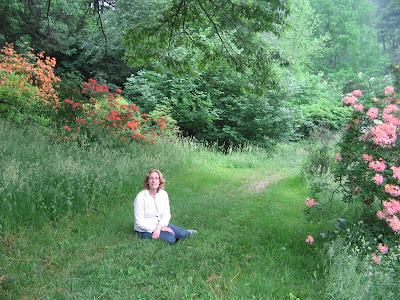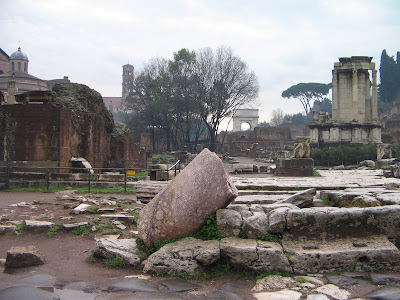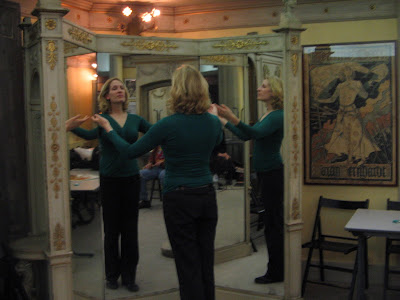
I had arranged to return to Paris one day early to have a more civilized time catching my return flight, and to finally do the sightseeing I hadn't done during the week before. It was to be another day of solitude, alas, and even though I have a few acquaintances in Paris it was my own ghosts that were more readily available for company. I left Rome early, arrived at my fleabag hotel right back in Montmartre off the Rue des Abbesses and dropped off my suitcase although my room wasn't ready. It was a cool drizzly morning, before the museums opened, so I bought myself a baguette from the usual bakery and sat in a cobblestone courtyard before I set off.

After the shopping, and realizing that I had limited time to travel to the sights, much less spend much time there, I hopped into the metro to head to the opera.
There was a photo shoot going on that day, which is why this picture is so nicely illuminated. I stood for a while admiring the Chagalls, choosing just to enjoy, and not peer through the view finder. For me to set foot in the Paris Opera house was to turn 13, when, don't laugh, I was slavishly obsessed with the Phantom of the Opera, first the musical then the book. I walked through the halls playing make believe, seeing the grand ladies and tailored gentlemen of the past, as if they could step out of the gilded statuary.
I tried to read my street map in the dim lavender light, hoping to prepare for an urban stroll. But I was too fearful of losing my way, and too self-conscious to walk the streets with a book in hand, so I permitted myself only a brief walk around the area before I went back to the metro for my next destination.
Paris is like a very Parisian New York. Urban, crowded, busy, and fast-paced, but set against a backdrop of elegance, cleanliness, quality, and beautiful detail. I was there during the chaotic post-Christmas sales, when people descend on stores like wasps. If only I had an eye for style and a bottomless wallet, I too would have sorted through the goods on street corners, where vendors sell designer shoes like New York sidewalk salesmen sell fruit.
For my one day I chose a museum slightly off the beaten path: the Guimet, which houses an expansive and particularly beautiful collection of Asian art, mostly Buddhist. Click here for my highlights tour. (I'm still trying to work out how to post it here directly.) Can you feel anything but peaceful there?
I lingered because I knew that the real feature that I wanted to visit would be open late, the l'Orangerie with its oval rooms of Monet water lilies. It was the one stop I absolutely wanted to make, because my first visit the museum was as crowded a subway, and I left the paintings feeling angry and cheated, surely the opposite of the intended effect. But arriving at 8 pm on a Saturday, the museum was as still as a pond. Informed by the stern admissions lady that "you 'ev an 'our," I ducked down the stairs into the grotto below.
Monet himself designed the rooms for these lilies, and their size and shape are just as important to the experience as the colors and shapes in the paintings. To experience them as one of only a few visitors, pastels floating from ceiling to floor, is to be inside an aquarium, or maybe the brain of Odilon Redon. I went to the second room first, where a young family was lingering, their son softly snoring on the central oval bench. I soon realized that the other visitors provide perspective on the rest of the painting, like mangrove trees or storks in a luminous swamp. I circled around the room like a pilgrim, zooming in on the dancing abstractions in the panels, or drifting back to admire the whole effect. The couple's smiles and the child's slumbering only added to the peaceful effect.
My companions in the first room, the one with the sunrise, were two Japanese fashion plates who used the art as a backdrop to their constant chitchat. They were the flies ruining the picnic. Eventually they tired, took a picture using a flash, and left.
As we approached closing time it was only me and one other visitor going back and forth between the two rooms, like barges or night watchmen. We were buoys to each other's experience, we circled politely in complementary circles, each one attempting to stay out of each other's sight line, or glancing in each other's direction for a perspective. The museum guards eventually encircled us, closing off one room with their bodies and then the other. I wondered if my companion and I had entered an unspoken contest to see who would outlast the other. I chose to leave first, leaving the memory of the lilies first in my mind and not a brusque escorted exit with the guards. Here is a spot from the painting that looks like a smiley face:
Leaving the grotto and entering the misty night was like going from one moist body of humidity to another. The chill was milder in Paris than it was in Rome, more like a companionable embrace from a stranger than a cold remonstrance from an old love. I walked through the Tuileries to make my way to a bus stop. With the Louvre in front of me I realized I was probably passing the very spot where I sat, years earlier, listening to man explain to me that he hadn't needed me for a very long time. I walked on, and sure enough my ghost eventually joined me, with baby fat and her hair in unfortunate bangs. We walked in silence, she still sad and I only able to offer my company as solace. I offered to take her out to ice cream, but she demurred, and the next time I looked up, she had slipped back silently into the swampy air.
So I went on to the Ile de la Cite alone, enjoying the last scoop of salted caramel before Berthillon's closed. It was across from a luxurious shop window, which caught my eye when I saw something move in the window:
The one old friend I could meet in town was Nathalie, the art historian I had met through others in Rome. I made my way to the end of a metro line to a neighborhood far more authentic looking than most of the tourist areas I had seen, but elegant and lively. She lives with with her boyfriend in a lovely one-bedroom that is filled with books, modern furniture, and snapshots of the couple gazing at each other. The peeling ceiling paint and small window seat of her tiny kitchen made me wonder if Julia Child had lived in a place like this when she was in Paris. Even the small foyer outside her apartment door was simple, sturdy, and beautiful:

I found a late-night cafe along the Rue des Abbesses in Montmartre, frequented by the occasional tourist and seedy characters from the nearby red-light district. I mouse-like man with a rumpled top hat sat near me, trying to make conversation in bits of French and English. "I wrote poetry," he told me, "I have a MySpace page." I finished my salad of frisee, tough beef, and cold goose fat and returned to the fleabag, spending a fitful night on an awful bed covered in hairs. The community shower, I discovered the next morning, was operated by a special coin, available only from the proprietors. The family apparently made a home for themselves behind the front desk, and I had to wait until they woke up before I could knock on their door for a coin.
The most eventful part of the trip lay before me. Most people would have showered and gone straight to the airport. I lingered for one more stroll around the hood, one more glance at the spectacular butcher shops with their jewel-like racks of glistening meats, one more sip of coffee and plate of attitude at the bakery, another duck into a supermarket, and oh what the heck another snack at another bakery. I then set off for Charles de Gaulle.
I not only left scant time, I didn't quite know where I was going. Words cannot describe an experience at that particular pit of hell, but I will try. There are two places to get off at Charles de Gaulle, the right one, where the planes are, and the wrong one, where the trains are. I somehow opted for the latter. After exiting the train and realizing that I was not only in the wrong place but also had no cash, I frantically asked a conductor how to get to the airport. He explained to me, and I went on my way, only to flip out, get confused, and come back and ask him to clarify in English! I finally got on the right train, nervously nibbling on a salty speck baguette.
Then there's the sorry airport itself. The traveller must know that her airline is housed in D16 or F29, and take the most convoluted paths to get there. There is no clear arrangement of the terminals-like every other airport in the world-information booths tend to be closed, and wherever you are, you are always very, very far away from where you need to be. The airport in Guatemala City is easier to navigate.
But the mistake lay entirely with me. I arrived at Charles de Gaulle with no ticket in hand, no flight number, and merely a hazy recollection of my itinerary. I was focused on other elements of the trip-like singing!-and the tour manager hadn't reconfirmed the trip with me. When I finally managed to find my airlines, I couldn't find myself when I tried to check in. With 50 minutes to go before I had to board a plane, I was directed to a long, stagnant line of passengers with problems. With my heart pounding and tears welling up as I considered that I would need to spend all of my fee on a new flight, I miraculously found an internet kiosk, where I checked my email with trembling fingers to discover that I was not flying through London, as the tour manager had originally informed me, but flying direct. Luckily, I had the time and date right. With this revelation I took the people mover to the check-in to the monorail to security to the shuttle bus to the gate, and waited with everyone else: the flight was delayed.
And so adieu, to my first trip as a true professional musician, to another Paris and a completely fresh set of memories, to new and old friends and colleagues, to new and renewed visions of beauty. And to my ghosts, be they living or dead. Until we meet again.



















 The central post office, in a restored villa.
The central post office, in a restored villa.

















